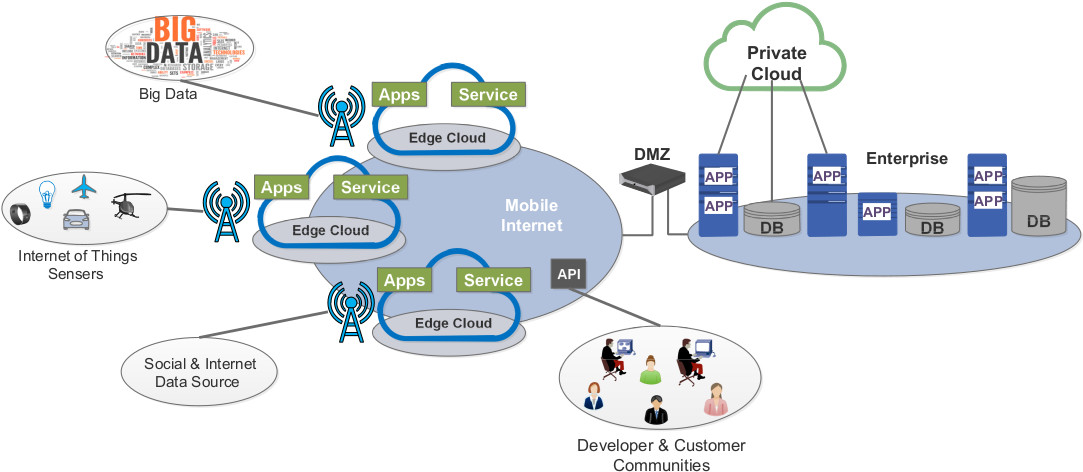5G : Multi-access Edge Computing (MEC)
5G expected to deliver data in the order of Gbps and end-to-end latency in order of few milliseconds. This will help to support a variety of services that require very high data rate and very low latency such as UHD video streaming, virtual reality, tactile Internet, M2M communication, and critical infrastructure monitoring. Multi-access Edge Computing (MEC) is regarded as a key technology to bring application-oriented capabilities into the carriers' network, in order to explore this wide range of applications, especially those with low latency requirements. The environment of MEC is characterized by the low latency, proximity, high bandwidth, and real-time insight into radio network information and location awareness. MEC opens up services to consumers and enterprise customers as well as to adjacent industries that can now deliver their mission-critical applications over the mobile network.

Furthermore, a traditional network system for communication and typical data centre based cloud infrastructure would no longer be enough for applications which require knowledge of context coupled with fine-grained location information, and low latency communications. A network that is capable of providing contextual information in addition to low latency communication along with application platform is required, that could exploit the contextual information provided by the network to provide an ad hoc real-time collaboration in a given geographical area. This could indeed be achieved by combining a MEC based application platform with the communication and context services that could be provided by potential 5G technologies.
[J1]ShashwatKumar, Sai VineethDoddala, Antony Franklin,and JiongJin"RAN-aware adaptive video caching in multi-access edge computing networks ", Journal of Network and Computer Applications, Oct, 2020.[Accepted Version ] [DOI Link]
[C1] Supriya Dilip Tambe, Yogesh Mandge, and Antony Franklin, " Performance Study of Multi-access Edge Computing Deployment in a Virtualized Environment ", Workshop on 5G: From Theory to Practice, IEEE 5G World Forum, September 2020. [Accepted Version ] [DOI Link]
[J2] Supriya Dilip Tambe,and Antony Franklin, "Multi-access edge computing in cellular networks", CSI Transactions on ICT, May, 2020. [Accepted Version ][DOI Link]
[D1] Supriya Tambe , Yogesh Mandge and Jyoti Tiwari presented Demo at NCC 2019, IISc Banglore on 'Real Time Video Caching Over Low Latency MEC in OAI LTE Network' as a part of 5G Testbed Project.
[C2] Shashwat Kumar, Doddala Sai Vineeth, and Antony Franklin,"Edge Assisted DASH Video Caching Mechanism for Multi-access Edge Computing", in Proc. of IEEE International Conference on Advanced Networks and Telecommunications Systems (ANTS), 2018.
[Accepted Version] [DOI Link] [Presentation]
[C3] Shashwat Kumar and Antony Franklin,"Consolidated Caching with Cache Splitting and Trans-rating in Mobile Edge Computing Networks", in Proc. of IEEE International Conference on Advanced Networks and Telecommunications Systems (ANTS), 2017.
[Accepted Version] [DOI Link] [Presentation]
[C4] Shashwat Kumar, Himank Gupta, and Antony Franklin,"Experimental Evaluation of YouTube Performance on MPTCP-based LTE-WLAN Integration", in Proc. of IEEE International Conference on Advanced Networks and Telecommunications Systems (ANTS), 2017.
[Accepted Version] [DOI Link] [Presentation]
[W1] Amogh P C, Debashisha Mishra, Bheemarjuna Reddy Tamma, et al., "A White Paper on An Upstream Project for OPNFV", 2017. [DOI Link]